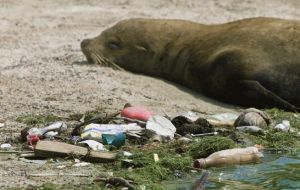MercoPress. South Atlantic News Agency
Plastic debris in the Atlantic Ocean seems to have peaked, say US scientists
 The study covers 22 years, but overall is quite distant from research in the Pacific
The study covers 22 years, but overall is quite distant from research in the Pacific A study has measured the amount of plastic debris found in a region of the Atlantic Ocean over a 22-year period. US researchers, writing in Science, suggest the volume of plastic appeared to have peaked in recent years.
One reason could be tighter marine pollution rules that prevent vessels dumping their waste at sea. The team said monitoring the free-floating plastic also provided an insight into the behaviour of ocean surface currents.
They found plastic, most pieces measuring no more than a few millimetres, in more than 60% of 6,136 samples collected by dragging fine-meshed nets along the ocean's surface.
The researchers from the US-based Sea Education Association (Sea) Woods Hole Oceanographic Institution and the University of Hawaii described plastic as a “major contaminant”.
“Plastic marine pollution is a significant environmental concern, yet a quantitative description of the scope of this problem is the open ocean is lacking,” they wrote.
“Their chemically engineered durability and slow rate of biodegradation allow these synthetic polymers to withstand the ocean environment for years to decades or longer.”
The impacts caused by the debris include: sea animals becoming entangled; seabirds and other marine creatures eating the plastic; the debris being used as a “life raft” by some species to reach areas outside their normal distribution range.
“While high concentrations of floating plastic debris have been found in the Pacific Ocean, only limited data exist to quantify and explain the geographical range,” they said. “In the Atlantic Ocean, the subject has been all but ignored.”
The team analysed data from ship surveys collected over 22 years between 1986 and 2008, which involved in excess of 6,000 net tows that gathered more than 64,000 pieces of plastic.
The largest number of plastic pieces in the data set was collected in 1997, in which 1,069 pieces were recovered by researchers in a single 30-minute tow. This equated to 580,000 pieces per square kilometre.
The team observed that the highest concentrations of floating plastic were “clearly associated” with a convergence of surface ocean currents and prevailing winds.
“This convergence zone... extends across most of the sub-tropical North Atlantic basin,” they reported. This correspondence not only explains the plastic distribution, but also illustrates how floating debris acts as a tracer of large-scale mean surface currents.“
Using a series of tracers, the team was able to estimate that it took fewer than 60 days for plastic to be carried to the ”collection centre“ from coastal waters on the eastern shores of the US.
As for the source of the plastic, the team said that there was no study that quantified the volume of plastic entering the ocean. However, they suggested that the increase recorded over the study period was likely to have come from land-based sources.
They said the global production of plastic materials had increased five-fold between 1976 and 2008, and the amount thrown away in the US has risen four-fold during the past two decades.
Meanwhile, the volume being dumped by vessels had fallen as a result of rules introduced in 1988 that prohibited the dumping of plastic at sea. But the team said that the projected increase in plastic from land sources was not reflected in the data gathered by the ship surveys.
”It is unlikely that ocean circulation could account for an export of plastic from the region large enough to offset the presumed increase in input,“ they suggested.
They offered a number of possible reasons for the discrepancy, including the plastic being broken down into pieces that were too small to be captured by the surveys' tow nets, the debris sinking beneath the surface, or the material being ingested by animals.
In order to curb the long-term environmental impact of free-floating plastic in the world's oceans, the team said their study offered evidence that any effort that prevented discarded plastic from land sources from entering the water in the first place could be ”measurably effective.




Top Comments
Disclaimer & comment rules-

Read all commentsthe argentinians have been warned on this, why is it always the argies, argie this,, argie that, [poor argentina] should have gone to specsavers
Aug 22nd, 2010 - 08:47 pm 0Commenting for this story is now closed.
If you have a Facebook account, become a fan and comment on our Facebook Page!